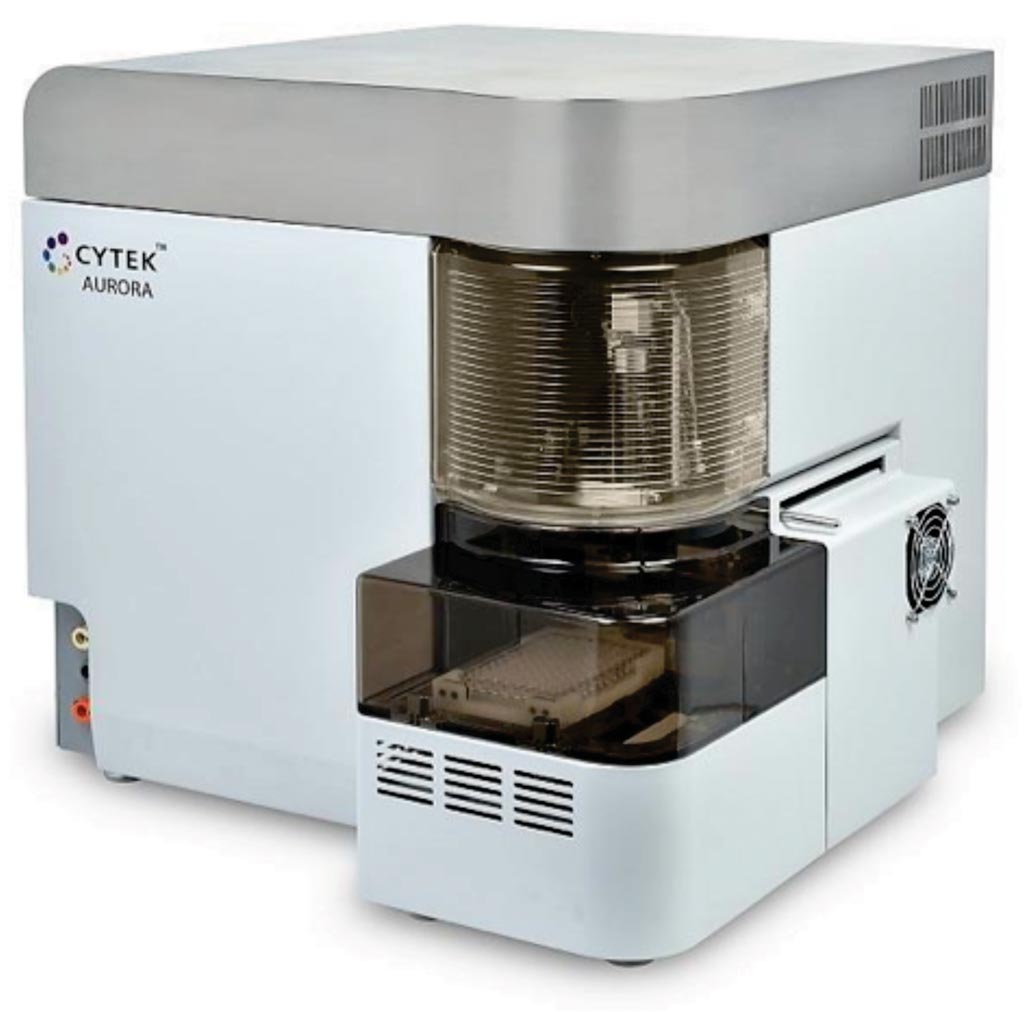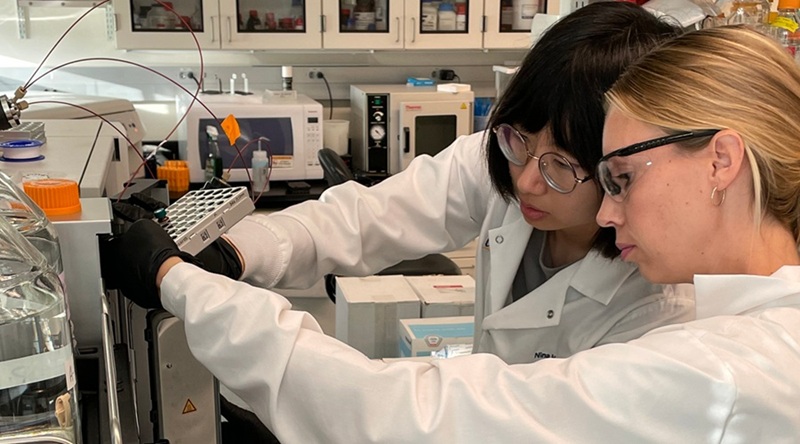Flow Cytometry Improved Updated Spectral Analyzer
|
By LabMedica International staff writers Posted on 31 Oct 2019 |

Image: The Aurora advanced flow cytometry system is now available with five lasers to enable seeing more than 30 colors from a single sample (Photo courtesy of Cytek Biosciences).
Flow cytometry aims to count the number, size, granularity, and other properties of cells in a heterogeneous population. Standard flow cytometry lasers excite certain fluorescent markers (fluorochromes, antibodies, or stains) on a cell as it passes through the beam.
Detectors in the instrument record and quantify the relative amount of light emitted by fluorescent markers in the cell, which the tool presents to scientists through a histogram. However, flow cytometer users can run into a myriad of technical issues, such as dealing with limited sample volumes and lacking enough lasers to excite a target amount of fluorochromes. Each laser also can only excite a certain number of fluorochromes on a cell before inducing spectral overlap.
An updated model of its Aurora flow cytometry system has been released by Cytek Biosciences (Fremont, CA, USA), which offers scientists the ability to multiplex 40 fluorescent biomarkers on a cell in a blood sample for scientific and clinical purposes. The updated Aurora platform uses five optical lasers (ultraviolet, violet, blue, yellow-green, and red) to excite 40 fluorochromes on cellular antibodies, which are then recorded by 64 detectors.
With standard flow cytometry panels, a patient's blood sample must be separated into multiple tubes to identify biomarkers linked to different types of leukemia; however the Aurora platform only needs a single tube of blood to identify the fluorescent antibodies. While scientists still need to run controls prior to running a multicolor tube to measure the different emission spectra recorded by Aurora, they can save the controls in the software and reuse them with the same panel in future tests.
Wenbin Jiang, PhD, CEO of Cytek Biosciences, said, “After chemotherapy, no one really has that many bone marrow samples available for testing and splitting into several different tubes. But because you don't need to split blood samples into several tubes with Aurora, you can have more cells per tube, which leads to more specific results." Dr. Jiang also argued that the updated Aurora system can analyze up to 30,000 to 40,000 cells per second while maintaining a "competitive sensitivity." Flow cytometry platforms on the market currently offer anywhere from 20,000 to 100,000 cells per second, but not always at the sample level of multiplexing.
Steven A. Porcelli, MD, scientific director at the Albert Einstein College of Medicine Flow Cytometry Core (Bronx, NY, USA), said, “Cytek's tool collected light coming out over a wide range of wavelengths for each cell and for each laser that we've used to excite the cell. Instead of giving you a high or low value for a tracer, it allows you to distinguish many different tracers from each other because you create a kind of fingerprint of the wavelengths being emitted.”
Related Links:
Cytek Biosciences
Albert Einstein College of Medicine Flow Cytometry Core
Detectors in the instrument record and quantify the relative amount of light emitted by fluorescent markers in the cell, which the tool presents to scientists through a histogram. However, flow cytometer users can run into a myriad of technical issues, such as dealing with limited sample volumes and lacking enough lasers to excite a target amount of fluorochromes. Each laser also can only excite a certain number of fluorochromes on a cell before inducing spectral overlap.
An updated model of its Aurora flow cytometry system has been released by Cytek Biosciences (Fremont, CA, USA), which offers scientists the ability to multiplex 40 fluorescent biomarkers on a cell in a blood sample for scientific and clinical purposes. The updated Aurora platform uses five optical lasers (ultraviolet, violet, blue, yellow-green, and red) to excite 40 fluorochromes on cellular antibodies, which are then recorded by 64 detectors.
With standard flow cytometry panels, a patient's blood sample must be separated into multiple tubes to identify biomarkers linked to different types of leukemia; however the Aurora platform only needs a single tube of blood to identify the fluorescent antibodies. While scientists still need to run controls prior to running a multicolor tube to measure the different emission spectra recorded by Aurora, they can save the controls in the software and reuse them with the same panel in future tests.
Wenbin Jiang, PhD, CEO of Cytek Biosciences, said, “After chemotherapy, no one really has that many bone marrow samples available for testing and splitting into several different tubes. But because you don't need to split blood samples into several tubes with Aurora, you can have more cells per tube, which leads to more specific results." Dr. Jiang also argued that the updated Aurora system can analyze up to 30,000 to 40,000 cells per second while maintaining a "competitive sensitivity." Flow cytometry platforms on the market currently offer anywhere from 20,000 to 100,000 cells per second, but not always at the sample level of multiplexing.
Steven A. Porcelli, MD, scientific director at the Albert Einstein College of Medicine Flow Cytometry Core (Bronx, NY, USA), said, “Cytek's tool collected light coming out over a wide range of wavelengths for each cell and for each laser that we've used to excite the cell. Instead of giving you a high or low value for a tracer, it allows you to distinguish many different tracers from each other because you create a kind of fingerprint of the wavelengths being emitted.”
Related Links:
Cytek Biosciences
Albert Einstein College of Medicine Flow Cytometry Core
Latest Technology News
- Machine Learning Models Diagnose ALS Earlier Through Blood Biomarkers
- Artificial Intelligence Model Could Accelerate Rare Disease Diagnosis
- AI Saliva Sensor Enables Early Detection of Head and Neck Cancer
- AI-Powered Biosensor Technology to Enable Breath Test for Lung Cancer Detection
- AI Model Achieves Breakthrough Accuracy in Ovarian Cancer Detection
- Portable Biosensor Diagnoses Psychiatric Disorders Using Saliva Samples
- Cell-Sorting Device Uses Electromagnetic Levitation to Precisely Direct Cell Movement

- Embedded GPU Platform Enables Rapid Blood Profiling for POC Diagnostics
- Viral Biosensor Test Simultaneously Detects Hepatitis and HIV
- Acoustofluidic Device to Transform Point-Of-Care sEV-Based Diagnostics
- AI Algorithm Assesses Progressive Decline in Kidney Function
Channels
Clinical Chemistry
view channel
Online Tool Detects Drug Exposure Directly from Patient Samples
Doctors often rely on patient interviews and medical records to determine what medications a person has taken, but this information is frequently incomplete. People may forget drugs they used, take over-the-counter... Read more
Chemical Imaging Probe Could Track and Treat Prostate Cancer
Prostate cancer remains a leading cause of illness and death among men, with many patients eventually developing resistance to standard hormone-blocking therapies. These drugs often lose effectiveness... Read moreMolecular Diagnostics
view channel
New 15-Minute Hepatitis C Test Paves Way for Same-Day Treatment
Chronic hepatitis C infection affects an estimated 50 million people worldwide and causes around 242,000 deaths each year, largely due to cirrhosis and liver cancer. Although the infection is curable with... Read more
Ovarian Cancer Assay Outperforms Traditional Tests in Early Disease Detection
Globally, ovarian cancer is one of the deadliest cancers affecting women. Traditionally, early diagnosis of ovarian cancer has been challenging. Many ovarian cancers are diagnosed only after they have... Read moreHematology
view channel
MRD Tests Could Predict Survival in Leukemia Patients
Acute myeloid leukemia is an aggressive blood cancer that disrupts normal blood cell production and often relapses even after intensive treatment. Clinicians currently lack early, reliable markers to predict... Read more
Platelet Activity Blood Test in Middle Age Could Identify Early Alzheimer’s Risk
Early detection of Alzheimer’s disease remains one of the biggest unmet needs in neurology, particularly because the biological changes underlying the disorder begin decades before memory symptoms appear.... Read more
Microvesicles Measurement Could Detect Vascular Injury in Sickle Cell Disease Patients
Assessing disease severity in sickle cell disease (SCD) remains challenging, especially when trying to predict hemolysis, vascular injury, and risk of complications such as vaso-occlusive crises.... Read more
ADLM’s New Coagulation Testing Guidance to Improve Care for Patients on Blood Thinners
Direct oral anticoagulants (DOACs) are one of the most common types of blood thinners. Patients take them to prevent a host of complications that could arise from blood clotting, including stroke, deep... Read moreImmunology
view channel
Routine Blood Test Can Predict Who Benefits Most from CAR T-Cell Therapy
CAR T-cell therapy has transformed treatment for patients with relapsed or treatment-resistant non-Hodgkin lymphoma, but many patients eventually relapse despite an initial response. Clinicians currently... Read more
New Test Distinguishes Vaccine-Induced False Positives from Active HIV Infection
Since HIV was identified in 1983, more than 91 million people have contracted the virus, and over 44 million have died from related causes. Today, nearly 40 million individuals worldwide live with HIV-1,... Read more
Gene Signature Test Predicts Response to Key Breast Cancer Treatment
DK4/6 inhibitors paired with hormone therapy have become a cornerstone treatment for advanced HR+/HER2– breast cancer, slowing tumor growth by blocking key proteins that drive cell division.... Read more
Chip Captures Cancer Cells from Blood to Help Select Right Breast Cancer Treatment
Ductal carcinoma in situ (DCIS) accounts for about a quarter of all breast cancer cases and generally carries a good prognosis. This non-invasive form of the disease may or may not become life-threatening.... Read moreMicrobiology
view channel
Blood-Based Diagnostic Method Could Identify Pediatric LRTIs
Lower-respiratory tract infections (LRTIs) are a leading cause of illness and death worldwide, and pneumonia is the leading infectious cause of death in children under five, claiming the lives of over... Read more
Rapid Diagnostic Test Matches Gold Standard for Sepsis Detection
Sepsis kills 11 million people worldwide every year and generates massive healthcare costs. In the USA and Europe alone, sepsis accounts for USD 100 billion in annual hospitalization expenses.... Read moreRapid POC Tuberculosis Test Provides Results Within 15 Minutes
Tuberculosis remains one of the world’s deadliest infectious diseases, and reducing new cases depends on identifying individuals with latent infection before it progresses. Current diagnostic tools often... Read more
Rapid Assay Identifies Bloodstream Infection Pathogens Directly from Patient Samples
Bloodstream infections in sepsis progress quickly and demand rapid, precise diagnosis. Current blood-culture methods often take one to five days to identify the pathogen, leaving clinicians to treat blindly... Read morePathology
view channel
Rapid Low-Cost Tests Can Prevent Child Deaths from Contaminated Medicinal Syrups
Medicinal syrups contaminated with toxic chemicals have caused the deaths of hundreds of children worldwide, exposing a critical gap in how these products are tested before reaching patients.... Read more
Tumor Signals in Saliva and Blood Enable Non-Invasive Monitoring of Head and Neck Cancer
Head and neck cancers are among the most aggressive malignancies worldwide, with nearly 900,000 new cases diagnosed each year. Monitoring these cancers for recurrence or relapse typically relies on tissue... Read more
Common Health Issues Can Influence New Blood Tests for Alzheimer’s Disease
Blood-based tests for Alzheimer’s disease are transforming diagnosis by offering a simpler alternative to spinal taps and brain imaging. However, many people evaluated at memory clinics also live with... Read more
Blood Test Formula Identifies Chronic Liver Disease Patients with Higher Cancer Risk
Chronic liver disease affects millions worldwide and can progress silently to hepatocellular carcinoma (HCC), one of the deadliest cancers globally. While surveillance guidelines exist for patients with... Read moreIndustry
view channel
Abbott Acquires Cancer-Screening Company Exact Sciences
Abbott (Abbott Park, IL, USA) has entered into a definitive agreement to acquire Exact Sciences (Madison, WI, USA), enabling it to enter and lead in fast-growing cancer diagnostics segments.... Read more

















